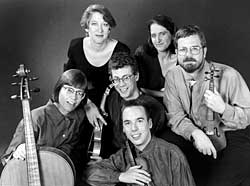The King's Noyse
April 2, 2000 Program
|
At the Paris Court of Charles IX (1570-90)
Anonymous: Mon Dieu la belle Entrée
Claude LeJune: Allons, allons gay
Claude LeJune: Je suis desheritée
Pierre Phalèse: Les Bouffons
Pierre Phalèse: Almade/Saltarello
Pierre Phalèse: Schiarazula Marazula
Anonymous: Ton amour ma maistresse
Phalèse: Pavane and galliard "La Battaille"
Anonymous: Laissez la verte couleur
The 17th c English ballad
Anonymous: The happy meeting
Anonymous: Boatman
Anonymous: Grimstock
Anonymous: Emperor of the Moon
Anonymous: Barbara Allen's cruelty
Anonymous: Strawberries and cream
Anonymous: Half hanniken
Anonymous: Nottingham ale to the tune of "Lilli Burlero"
|
| |
 |
 |
|
The King's Noyse
David Douglass, Director and violin
Robert Mealy, violin
Scott Metcalfe, viola
Margriet Tindemans, viola
Emily Walhout, bass violin
Paul O'Dette, lute
Ellen Hargis, soprano
Musician
Web Site
Musician
Discography
|
|
|
The English Ballad - Barbara Allen's cruelty
Ballad singing, a tradition dating back to the time of the troubadours
and still a part of folk music today, was a very popular form of entertainment
in 17th-century England. Just one anthology from the end of the century,
Wit and Mirth, or Pills to Purge Melancholy, contains more than one thousand
ballads. The ballad tunes were so well-known that, in most cases, the
ballad texts were published alone. One reason that the tunes were so familiar
was that professional dance bands, such as violin bands, used them for
improvising dance and division music. Professional musicians relied on
that public familiarity to provide music that would be at once both immediately
recognizable and yet brand new. This is still a part of professional music-making:
jazz and pop groups achieve the same effect when they "cover" a standard
tune.
Equal parts fragile melancholy and foot stomping jollity, English melodies
have broad appeal. The tune for Barbara Allen's cruelty is probably
one of the most recognizable melodies on this program. Since the most
famous source for the ballad and the earliest source for the ballad
tune is the 1745 edition of Bishop Percy's Relics of Ancient Poetry,
it has been commonly thought of as an 18th-century ballad. The thick,
complicated and often very beautiful harmonizations of Barbara Allen
that are familiar to us in this country make it even more difficult
to hear the tune as a late Renaissance song. But the 17th-century diarist
Samuel Pepys recounts hearing the "Scotch song of Barbara Allen" sung
by his favorite actress, Mrs. Knipp, and by Pepys' time it had probably
already been a popular favorite for many years. We are using a 17th-century
source for the text, and I have attempted to give this traditional standard
a distinctly 17th-century musical interpretation through the harmonization
and style of accompaniment.
A perpetual icon in popular culture since the 17th century, Barbara
Allen found one of its most famous modern uses in the 1951 cinematic
adaptation of Charles Dickens' A Christmas Carol, in which the opening
verse is sung at the Christmas Day dinner at the home of Scrooge's nephew.
The film's makers may have intended to draw a connection between Barbara
Allen's insensitivity and that of the unreformed Scrooge, who like Barbara
Allen is slow in making his way to the death bed of his "best friend,"
and relied on the movie audience to remember the meaning of the ballad.
It is amazing to think that a popular song could remain in the public's
collective consciousness for 350 years, but no one can doubt the enduring
nature of the ballad repertory which echoes, by design, life's experiences.
Excerpted from program notes by David Douglass
|
